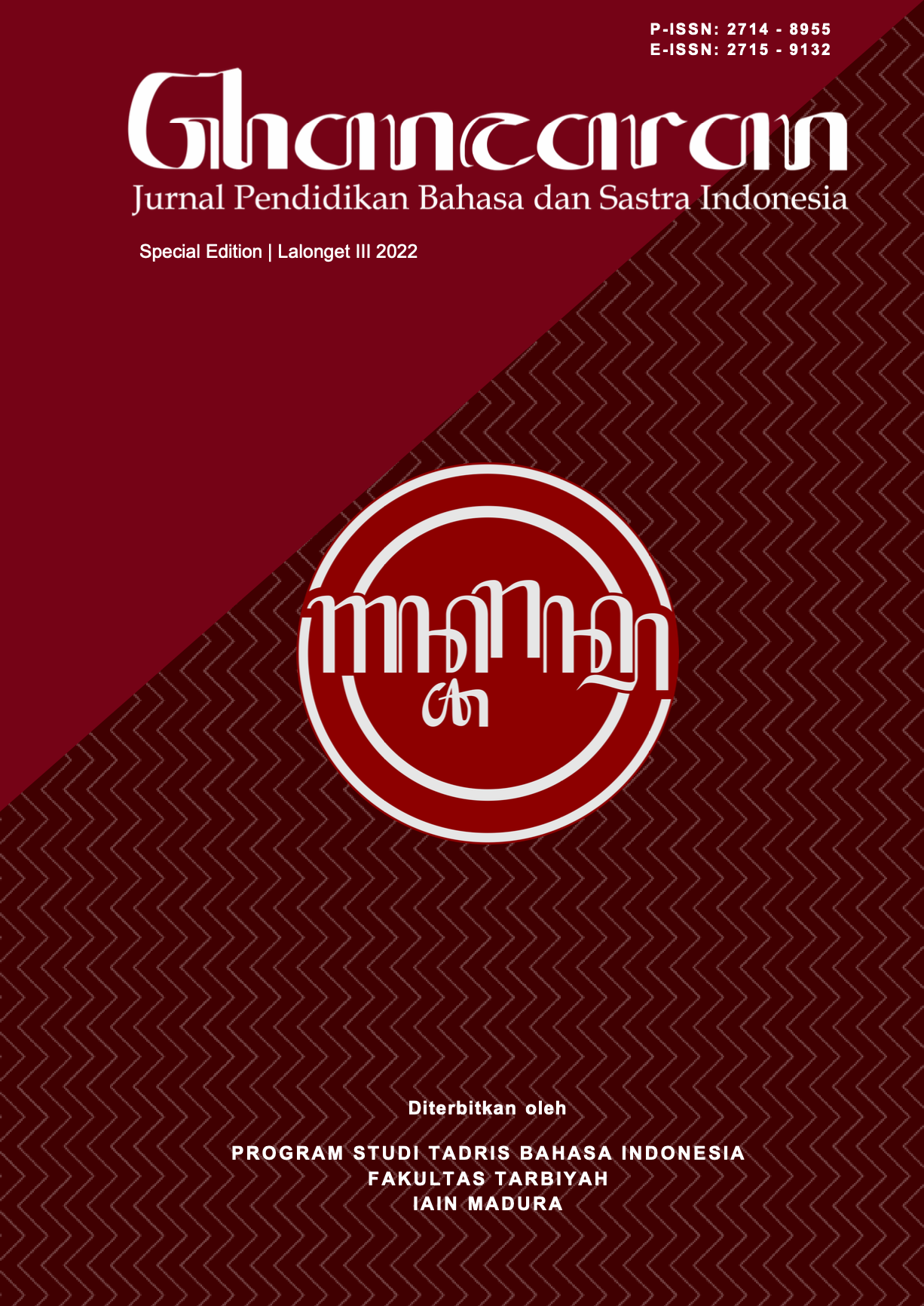Pembelajaran Menyimak Apresiatif Cerpen dengan Metode Story Telling di Kurikulum Merdeka Belajar
 Abstract views: 950
,
Abstract views: 950
,
 PDF downloads: 859
PDF downloads: 859
Abstract
The purpose of this research is to improve the learning of short story appreciative listening by using the storytelling method, especially in the era of independent learning. The short story taken is Kartini's short story by Putu Wijaya. This research uses descriptive qualitative method. The source of the data for this research is SMP NU Sumenep. Data were collected through observations, field notes, and documentation. Data analysis by collaborating data with the learning method used. The results showed that the storytelling method was effective in improving appreciative listening learning, especially to support the curriculum.
Downloads
References
Aminuddin. (2000). Metasemiotik sebagai Dasar Signifikasi Teks Sastra. Universitas Indonesia.
Bodgan, R. C., & Biklen, S. K. (1982). Qualitative Research for Education: An Introduction to Theory and Method. Allyn and Bacon Inc.
Dimyati, & Mudjiono. (1999). Belajar dan Pembelajaran. Rineka Cipta.
Jannah, M., & Darwis, U. (2021). Pengaruh Model Pembelajaran Paired Storytelling terhadap Keterampilan Menyimak Cerita Siswa Kelas IV SD Al-Washliyah 43 Firdaus. EduGlobal: Jurnal Penelitian Pendidikan, 1(01), 1–16.
Latif, M. A. (2012). The Miracle of Story Telling. In Zikrul Hakim. Zikrul Hakim.
Madyawati, L. (2016). Strategi Pengembangan Bahasa pada Anak. Kencana.
Mustafa, D. A. I. (2016). Pengembangan Bahan Ajar Pembelajaran Menulis Cerita Berbasis Pendekatan Proses bagi Siswa SMP. Prosiding Seminar Nasional Inovasi Pendidikan.
Nurgiyantoro, B. (2017). Penilaian Pembelajaran Bahasa Berbasis Kompetensi. BPFE Yogyakarta.
Nurhidayati, N. (2011). Pembelajaran Menyimak Apresiatif Cerita Pendek dengan Strategi Belajar Kooperatif. LITERA, 10(1).
Pratiwi, R. R. (2016). Penerapan Metode Storytelling untuk Meningkatkan Keterampilan Berbicara Siswa Kelas II SDN S4 Bandung. Jurnal Pendidikan Guru Sekolah Dasar, 1(1), 199–207.
Purwo, B. K. (1997). Pokok-Pokok Pengajaran Bahasa dan Kurikulum 1994 Bahasa Indonesia. Depdikbud.
Rosdiana, E., Kusmariyatni, N. N., & Widiana, I. W. (2013). Pengaruh Model Pembelajaran Kooperatif Tipe Paired Storytelling Berbantuan Media Audio Visual Terhadap Keterampilan Menyimak Bahasa Indonesia Siswa Kelas V Sd. Mimbar PGSD Undiksha, 1(1).
Syamsuardi, S., Musi, M. A., Manggau, A., & Noviani, N. (2022). Metode Storytelling dengan Musik Instrumental untuk Meningkatkan Kemampuan Menyimak dan Berbicara Anak. Jurnal Obsesi: Jurnal Pendidikan Anak Usia Dini, 6(1), 163–172.
Teeuw, A. (2015). Sastra dan Ilmu Sastra. PT. Dunia Pustaka Jaya.
Wibowo, A. (2013). Pendidikan Karakter Berbasis Sastra. Pustaka Pelajar.
Zebua, S. (2015). Pengembangan Bahan Ajar Membaca Sastra Indonesia dan Perangkat Penilaian Autentik. Jurnal Edukasi Kultura: Jurnal Bahasa, Sastra, dan Budaya, 2(2).
Copyright (c) 2022 GHANCARAN: Jurnal Pendidikan Bahasa dan Sastra Indonesia

This work is licensed under a Creative Commons Attribution-ShareAlike 4.0 International License.
Ghancaran: Jurnal Pendidikan Bahasa dan Sastra Indonesia uses an Open Access Policy under the Creative Commons Attribution-ShareAlike 4.0 International License. Authors publishing in this journal agree to the following terms:
- Ghancaran Journal holds the copyright and grants the journal rights for first publication with the work simultaneously licensed under a

The work is distributed under Creative Commons Attribution-ShareAlike 4.0 International License which allows others to share, copy, and redistribute the material in any media or format and adapt, remix, change, and develop the material even for commercial purposes, as long as it is stated credit and license derivative works under similar terms. - Authors may make additional contractual arrangements for non-exclusive distribution of the journal's published work version.
- Authors are permitted to post their work online (e.g., in institutional repositories or on their websites) before and during submission, as doing so may lead to productive exchange.



















